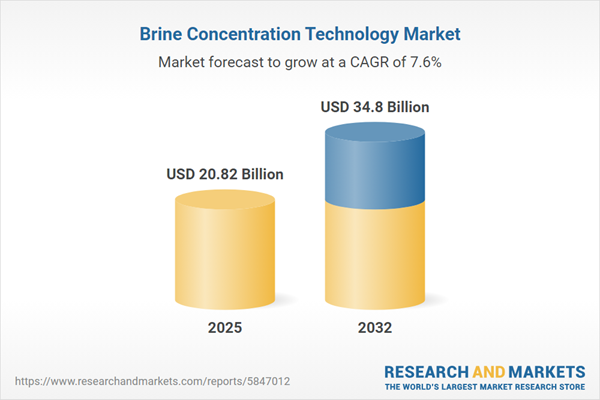Speak directly to the analyst to clarify any post sales queries you may have.
Brine concentration technology is advancing rapidly, emerging as a crucial solution for industries facing heightened water scarcity, regulatory scrutiny, and the need for enhanced resource recovery. Senior stakeholders now prioritize efficient, sustainable water management strategies that reduce environmental impact while supporting operational goals.
Market Snapshot: Brine Concentration Technology Market
The Brine Concentration Technology Market grew from USD 19.34 billion in 2024 to USD 20.82 billion in 2025. With a CAGR of 7.61%, projections indicate the market will reach USD 34.80 billion by 2032.
Applications range from chemical manufacturing and mining to power generation and oil and gas operations, where brine concentration technology supports operational efficiency and environmental stewardship.Scope & Segmentation
This report provides a comprehensive assessment across major technologies, industry verticals, application areas, and geographies:
- Technology: Hybrid (including membrane thermal hybrids), Membrane (nanofiltration, reverse osmosis, ultrafiltration), Thermal (multi-effect distillation, multi-stage flash, vapor compression)
- End User Industry: Chemicals, Food and Beverage, Mining, Oil and Gas, Power Generation
- Brine Source: Industrial Effluent, Municipal Wastewater, Produced Water, Seawater
- Application: Desalination, Mineral Recovery, Water Reuse, Zero Liquid Discharge
- Product Output: Brine Concentrate, Fresh Water, Minerals, Salt
- Capacity Range: Large Scale, Mid Scale, Small Scale
- Geographical Coverage: Americas (including North America and Latin America), Europe, Middle East & Africa, and Asia-Pacific
- Key Companies: Veolia Environnement S.A., Suez S.A., DuPont de Nemours, Inc., Toray Industries, Inc., Aquatech International LLC, Pentair plc, Alfa Laval AB, Ecolab Inc., BASF SE, Aquaporin A/S
Key Takeaways for Senior Decision-Makers
- Advanced membrane and hybrid brine concentration solutions are now central to both operational efficiency and meeting tightening regulatory standards in water-intensive sectors.
- Shifts toward digital monitoring and predictive process controls are driving longer asset lifecycles, minimizing maintenance needs, and supporting performance guarantees for service providers.
- Modular, standardized design options and equipment-as-a-service financing models are accelerating deployment and lowering adoption barriers, particularly for mid-tier and niche applications.
- Strategic cross-sector partnerships and joint ventures among technology providers are accelerating innovation and extending supply chain robustness into emerging markets.
- Adoption of zero-liquid discharge and mineral recovery schemes is enabling new sources of revenue and aligns solutions with circular economy objectives across industries.
Tariff Impact and Competitive Dynamics
Recent United States tariffs on key components such as membranes and specialty alloys have increased capital expenditure for brine concentration projects. This has encouraged equipment suppliers to pursue alternative sourcing, invest in domestic capacity, and explore modular product strategies that simplify supply chains. Service models are evolving, with greater use of performance-based contracts and leasing options to manage financial risk. Internationally, these policy shifts have driven increased collaboration and licensing, further fostering innovation diffusion and resilience across global markets.
Methodology & Data Sources
The report integrates primary research through executive and technical expert interviews with robust secondary analysis from peer-reviewed journals, technical databases, and regulatory publications. Quantitative insights, segmented by technology, industry, region, and application, are validated through triangulation using multiple independent sources and vendor case studies.
Brine Concentration Technology: Why This Report Matters
- Gain actionable, segmented market insights to inform strategic decisions in technology investment and deployment.
- Understand regional drivers, regulatory shifts, and technology trends influencing competitiveness and growth opportunities.
- Benchmark with detailed analysis of leading vendors, disruptive entrants, and evolving business models in the brine concentration field.
Conclusion
As the brine concentration technology market matures, advances in hybrid and membrane systems, responsive business models, and dynamic policy landscapes will shape future growth. Strategic alignment with evolving regulations and innovative partnerships remains essential for sustained success.
Additional Product Information:
- Purchase of this report includes 1 year online access with quarterly updates.
- This report can be updated on request. Please contact our Customer Experience team using the Ask a Question widget on our website.
Table of Contents
3. Executive Summary
4. Market Overview
7. Cumulative Impact of Artificial Intelligence 2025
Companies Mentioned
The companies profiled in this Brine Concentration Technology market report include:- Veolia Environnement S.A.
- Suez S.A.
- DuPont de Nemours, Inc.
- Toray Industries, Inc.
- Aquatech International LLC
- Pentair plc
- Alfa Laval AB
- Ecolab Inc.
- BASF SE
- Aquaporin A/S
Table Information
| Report Attribute | Details |
|---|---|
| No. of Pages | 199 |
| Published | October 2025 |
| Forecast Period | 2025 - 2032 |
| Estimated Market Value ( USD | $ 20.82 Billion |
| Forecasted Market Value ( USD | $ 34.8 Billion |
| Compound Annual Growth Rate | 7.6% |
| Regions Covered | Global |
| No. of Companies Mentioned | 11 |









